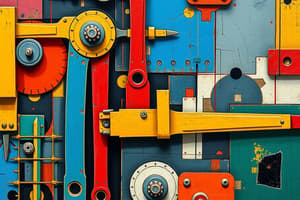Podcast
Questions and Answers
What is the definition of a 1st class lever?
What is the definition of a 1st class lever?
- Wheelbarrow
- Scissors (correct)
- Nutcracker
- Broom
What is the definition of a 2nd class lever?
What is the definition of a 2nd class lever?
- Tweezers
- Nutcracker (correct)
- Shovel
- Seesaw
What is the primary function of a 3rd class lever?
What is the primary function of a 3rd class lever?
- Built for power
- Mechanical advantage
- Built for speed (correct)
- Resistance/load
What does RAF represent in a 1st class lever?
What does RAF represent in a 1st class lever?
What does FRA represent in a 2nd class lever?
What does FRA represent in a 2nd class lever?
What does RFA represent in a 3rd class lever?
What does RFA represent in a 3rd class lever?
What is the definition of Resistance Arm (RA)?
What is the definition of Resistance Arm (RA)?
What is the definition of Force Arm (FA)?
What is the definition of Force Arm (FA)?
A 1st class lever can only have scissors as its example.
A 1st class lever can only have scissors as its example.
A wheelbarrow is an example of a 3rd class lever.
A wheelbarrow is an example of a 3rd class lever.
What is the definition of mechanical advantage?
What is the definition of mechanical advantage?
What is the definition of mechanical disadvantage?
What is the definition of mechanical disadvantage?
What does a class 2 lever provide?
What does a class 2 lever provide?
What does a class 1 lever signify?
What does a class 1 lever signify?
What does a class 3 lever signify?
What does a class 3 lever signify?
Flashcards are hidden until you start studying
Study Notes
Lever Classes
-
1st Class Lever (RAF-FAR): Force, Axis, Resistance arrangement.
- Examples: Scissors, Crowbars, Seesaws.
-
2nd Class Lever (FRA-ARF): Resistance, Force, Axis arrangement.
- Examples: Wheelbarrow, Nutcracker, Bottle opener.
-
3rd Class Lever (RFA-AFR): Force, Resistance, Axis arrangement.
- Examples: Broom, Shovel, Tweezers.
Lever Components
- Resistance Arm (RA): Distance between resistance and the axis.
- Force Arm (FA): Distance between force applied and the axis.
- Axis: The fulcrum around which the lever pivots.
Mechanical Concepts
- Force: Refers to the effort applied to the lever.
- Resistance: Refers to the weight or load that the lever must overcome.
- Mechanical Advantage: Indicates design for greater power; typically seen in 2nd class levers.
- Mechanical Disadvantage: Design geared towards speed; common in 3rd class levers.
Lever Class Implications
- Class 1 Lever: Can provide either mechanical advantage or disadvantage, depending on its design.
- Class 2 Lever: Always designed for mechanical advantage.
- Class 3 Lever: Engineered for mechanical disadvantage, emphasizing speed over power.
Studying That Suits You
Use AI to generate personalized quizzes and flashcards to suit your learning preferences.




